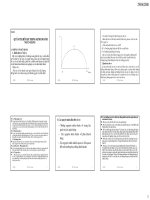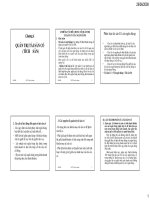slike bài giảng quản trị ngân hàng chương 2 financial statements of bank
Bạn đang xem bản rút gọn của tài liệu. Xem và tải ngay bản đầy đủ của tài liệu tại đây (10.29 MB, 52 trang )
William Chittenden edited and updated the PowerPoint slides for this edition.
FINANCIAL
STATEMENTS OF BANKS
Chapter 2
Key topics
1. 1. Overview of the Balance sheets and Income
statements of banks
2. 2. Balance sheet or Report of condition
1. Asset items
2. Liability items
3. 3. Recent expansion of off-balance sheet items
4. 4. Components of the Income statement: Revenues
and Expenses
5. 5. Financial statement manipulation
Bank financial statements
Report of condition – Balance sheet
Report of income – Income statement
5-4
Report of condition - Balance sheet
The Balance sheet of a bank showing its Assets,
Liabilities and Net worth at a given point in time
Assets = Liabilities + Equity
May be viewed as a list of financial inputs (sources
of funds) and outputs (uses of funds)
C + S + L + MA = D + NDB + EC
C = Cash assets
S = Security holdings
L = Loans
MA = Miscellaneous
assets
D = Deposits
NDB = Non-deposit
borrowings
EC = Equity capital
5-6
Balance sheet
Bank assets
Cash and due from banks
Vault cash, deposits held at the Fed and other financial
institutions, and cash items in the process of collection
Investment securities
Securities held to earn interest and help meet liquidity
needs
Loans
The major asset, generate the greatest amount of
income, exhibit the highest default risk and are relatively
illiquid
Other assets
Bank premises and equipment, interest receivable,
prepaid expenses, other real estate owned, and
customers' liability to the bank
Balance Sheet (assets): PNC and Community National Bank
Cash assets
Account is called cash and deposits due from bank
Includes:
Vault cash
Deposits with other banks (correspondent deposits)
Cash Items in process of collection
Reserve account with the Federal Reserve
(sometimes called primary reserves)
5-9
Securities: the liquid portion
Often called secondary reserves, include:
Short term government securities
Privately issued money market securities
Interest bearing time deposits
Commercial paper
5-10
Investment securities
These are the income generating portion of
securities
Taxable securities
U.S. Government notes
Government agency securities
Corporate bonds
Tax-exempt securities
Municipal bonds
5-11
Trading account assets
Securities purchased to provide short-term profits
from short-term price movements
When bank acts as a securities dealer
Valued at market – FASB 115
5-12
Federal funds sold and reverse
repurchase agreements
A type of loan account
Generally overnight loans
Federal funds sold - funds come from the deposits at
the Federal Reserve
Reverse repurchase agreements – bank takes
temporary title to securities owned by borrower
5-13
Bank investments and FASB 115
Following FASB 115, a bank, at purchase, must designate the
objective behind buying investment securities as either:
Held-to-maturity securities are recorded on the balance sheet at
amortized cost.
Trading account securities are actively bought and sold, so the
bank marks the securities to market (reports them at current
market value) on the balance sheet and reports all gains and
losses on the income statement.
Available-for-sale, all other investment securities, are recorded
at market value on the balance sheet with a corresponding
change to stockholders’ equity as unrealized gains and losses
on securities holdings; no income statement impact.
Bank investments and FASB 115
amortized cost, market value (fair value)
/>id=c3f0AegbDx4C&pg=PA221&lpg=PA221&dq=amortized+
cost&source=bl&ots=PYzqn9tqrJ&sig=0qSsODiLgsl3_fDOZ
JWo91L4Zu8&hl=vi&ei=RfKHS6PBKNegkQWUgrmhDw&
sa=X&oi=book_result&ct=result&resnum=7&ved=0CCUQ6
AEwBg#v=onepage&q=amortized%20cost&f=false
Loan accounts
The major asset
Gross loans – sum of all loans
Allowance for possible loan losses
Contra asset account
For potential future loan losses
Net loans
Unearned discount income
Nonperforming loans
5-16
Types of loans
Commercial and industrial loans
Consumer loans (loans to individuals)
Real estate loans
Financial institution loans
Foreign loans
Agriculture production loans
Security loans
Leases
5-17
Adjustments to total loans
…three adjustments are made to obtain a net loan
figure.
1. Leases are included in gross loans.
2. Unearned income is deducted from gross
interest received.
3. Gross loans are reduced by the dollar
magnitude of a bank's loan-loss reserve,
which exists in recognition that some loans
will not be repaid.
Specific and general reserves
Specific reserves
Set aside to cover a particular loan
Designate a portion of ALL or
Add more reserves to ALL
General reserves
Remaining ALL
Determined by management but influenced by taxes and
government regulation
Loans to lesser developed countries require allocated
transfer reserves
ALL : Allowance for loan losses
5-19
Allowance for loan losses (ALL)
Beginning ALL
+ Provision for loan loss (Income statement)
= Adjusted allowance for loan losses
-
Actual charge-offs
+ Recoveries from previous charge-offs
= Ending allowance for loan losses
VN: see Decision 493/2005/QD-NHNN
5-20
Provisions for loan losses
Provisions for loan losses
Reserve for Loan Losses
Recoveries
Charge offs
Average assets, capital and loan loss data: PNC and Community NB
Miscellaneous assets
Bank premises and fixed assets
Other real estate owned (OREO)
Goodwill and other intangibles
5-23
Bank liabilities
Non interest-bearing demand deposits
Transactions accounts that pay no interest
Negotiable orders of withdrawal (NOWs) and
automatic transfers from savings (ATS) accounts
Pay interest set by each bank without federal
restrictions
Money market deposit accounts (MMDAs)
Pay market rates, but a customer is limited to no more
than six checks or automatic transfers each month
Savings and time deposits represent the bulk of
interest-bearing liabilities at banks.
Bank liabilities (cont.)
Two general time deposits categories exist:
Time deposits in excess of $100,000, labeled
jumbo certificates of deposit (CDs).
Small CDs, considered core deposits which tend
to be stable deposits that are typically not
withdrawn over short periods of time.
Deposits held in foreign offices
Balances issued by a bank subsidiary located
outside the U.S.









